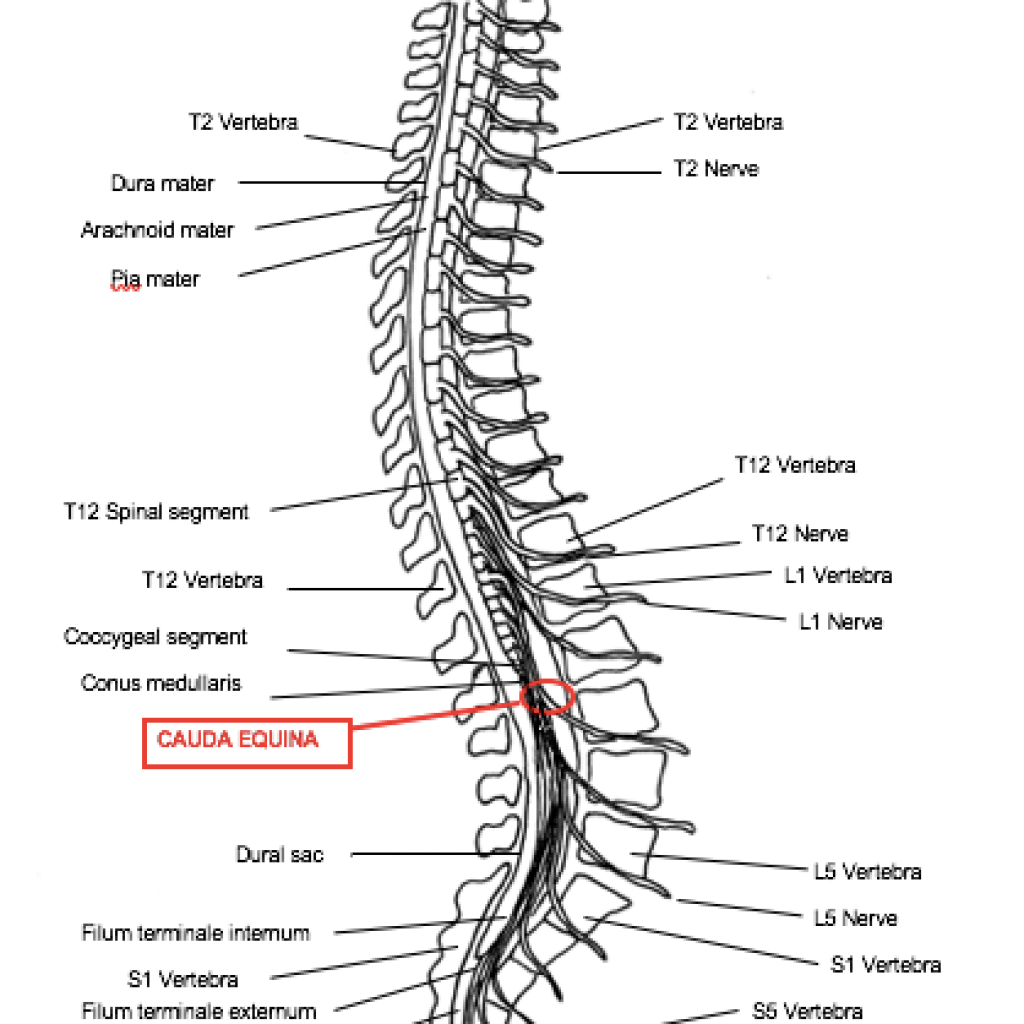What is the cauda equina?
The cauda equina is a collection of spinal nerves and nerve roots below the tapered end of the spinal cord, or conus medullaris. It consists of the second through to the fifth lumbar nerve pairs, all sacral nerve pairs, and the coccygeal nerve. These nerve roots are called cauda equina nerve roots because early anatomists thought they looked like a horse’s tail. Cauda Equina is Latin for “horse’s tail”. The cauda equina nerves control bladder and bowel, sexual function, sensation in the groin area, and motor function throughout the legs.
What is Cauda Equina Syndrome and what causes it?
Cauda Equina Syndrome (CES) occurs when the cauda equina is damaged leading to compression of the nerve roots below the level of the spinal cord. Damage can be caused by a slipped disc, surgery to the lower back, spinal tumours inflammatory conditions such as Paget’s disease and ankylosing spondylitis, and infectious conditions such as spinal or epidural abscesses.
What is the most common cause of Cauda Equina Syndrome?
A prolapsed or slipped disc is the most common cause of Cauda Equina Syndrome. When this happens the inner part of a vertebral disc pokes through a weakness in the outer layer, pressing on the surrounding structures.
What are the Symptoms of Cauda Equina Syndrome?
Symptoms of Cauda Equina Syndrome may include:
- inability to pass urine
- urinary and/or faecal incontinence
- numbness in the groin
- leg weakness
These are known as “red flag” symptoms. Cauda equina syndrome compensation claims can arise when doctors fail to advise patients to seek medical attention urgently if they develop ‘red flag’ symptoms.
Failure to provide appropriate advice can result in a delay in patients attending the hospital when these “red flag” symptoms develop.
When these symptoms occur, if the nerves are not decompressed in time, the symptoms may be permanent.
What are the main types of cauda equina syndrome (CES)?
- CES-R, where urinary retention is already established.
- CES-I, which is incomplete, where urinary sensation is reduced, there is a loss of the feeling of the need to empty the bladder or a poor stream of urine, but there is no established urinary retention or overflow (incontinence/leakage).
When a patient has cauda equina syndrome, surgical decompression of the nerve roots must be carried out urgently. Delays in surgery can result in serious and permanent disabilities including foot drop, numbness and loss of sensation to the legs and groin area, very severe back pain, bladder and bowel dysfunction, and sexual dysfunction.
How is Cauda Equina Syndrome Diagnosed?
It is usually diagnosed by imaging (typically an MRI scan) along with taking a history and examining the patient. The physical examination will include testing the muscle strength of the lower limbs, evaluating sensation to touch and pain, checking lower limb reflexes, and evaluating anal tone, reflex, and sensation. X-rays will look for severe arthritis and trauma, an MRI with and without contrast will provide a detailed look at tumours, infection, intervertebral disks, and nerve roots.
How do you prevent permanent damage from Cauda Equina Syndrome?
Early diagnosis by identifying the symptoms of is key to preventing permanent damage. Low back pain with leg pain and/or weakness is a common complaint that affects many people but Cauda Equina Syndrome is a rare complication. Recovery depends on early intervention. Late diagnosis and treatment lead to more complications and increases the risk of permanent neurological damage, a degree of bladder and/or bowel dysfunction may be permanently lost.
How is Cauda Equina Syndrome treated?
Cauda Equina Syndrome is considered a medical emergency and often prompt surgical decompression of the roots is required to prevent permanent neurological damage. Typically, a microdiscectomy is performed – a procedure whereby the surgeon removes the part of the disc compressing the nerves.
What happens following surgery?
Even after surgery, many issues may persist and there may be a need for Physiotherapy and Occupational Therapy, Pain management and management of urological and bowel problems as well as management of problems with sexual function. With the reduced mobility that some sufferers subsequently have, obesity can also be a real issue following cauda equina syndrome.
Is it possible for someone to suffer a second episode of Cauda Equina Syndrome?
Unfortunately, even if cauda equina syndrome is properly treated the first time, there is a 5% chance that the disc will slip a second time.
During surgery to decompress the affected nerves, it is unusual for the surgeon to remove the disc entirely as the surgery is a very complex procedure. Even if cauda equina syndrome is managed appropriately the first time round, the disc will still be very weak and a patient can suffer cauda equina syndrome from a prolapsed disc for the second time.
How is a recurrent prolapse managed?
If a patient does suffer a second bout of cauda equina syndrome, it is essential that the condition is diagnosed and treated immediately.
The fact that a patient has a history of cauda equina compression should make medical practitioners alert to the possibility of a recurrent disc prolapse. This should speed up a diagnosis, to ensure that a patient receives timely decompression surgery.
If medical practitioners fail to realise that a patient has recurring cauda equina syndrome, the level of care will be deemed substandard. If this causes a patient to suffer unnecessary injuries, there will be grounds for medical negligence claims.
Tozers LLP has represented several claimants who have been successful in obtaining compensation after they brought compensation claims relating to cauda equina. This includes cases in which a secondary cauda equina is thought to have occurred.
How we can help
Please contact Endurance Arthur from our Medical Negligence team if you believe you or someone you know may have suffered injury as a result of medical negligence because of a delay in the management of your cauda equina syndrome or other clinical negligence. Our expert medical and clinical negligence solicitors can help you obtain compensation for your injuries, past losses, and expenses. Where appropriate, compensation can also be obtained to help provide for your future, including for care, loss of earnings, therapies, special accommodation, and/or equipment needs.





